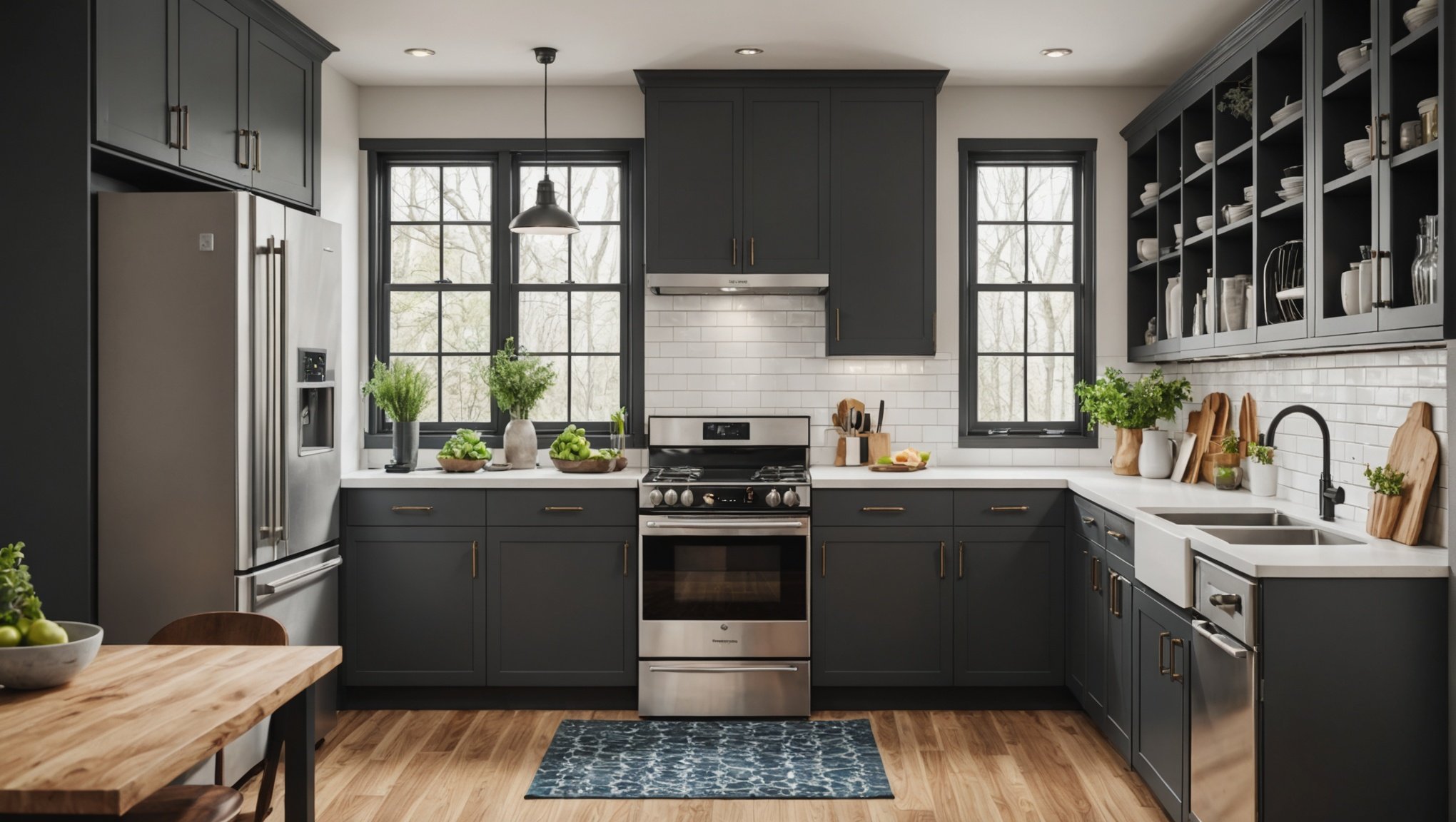Understanding High-Efficiency Appliances
High-efficiency appliances are increasingly becoming a popular choice for modern homes and kitchens. These energy-efficient kitchen appliances are designed not only to perform their functions with minimal environmental impact but also to conserve energy. By using advanced technology, such as improved insulation and innovative engineering, high-efficiency appliances operate on less electricity compared to traditional models.
Benefits of Using High-Efficiency Appliances
In tiny home kitchens, every bit of energy conservation matters. High-efficiency appliances help homeowners save on utility bills by reducing energy consumption. This is particularly important in compact living spaces, where every appliance must maximise performance without compromising usability. Moreover, these appliances often have a smaller carbon footprint, contributing positively to environmental sustainability.
Overview of Energy Ratings
Understanding energy ratings is crucial when selecting high-efficiency appliances. These ratings provide insights into how an appliance performs in terms of energy consumption. Labels such as Energy Star in the UK and Europe indicate compliance with specific energy-saving guidelines. Such labels can guide consumers in making informed decisions when purchasing energy-efficient kitchen appliances. By opting for appliances with higher rating scores, consumers can ensure they are making not only a smart financial investment but also supporting a greener lifestyle.
By choosing high-efficiency appliances, individuals can enjoy the dual benefits of cost savings and contributing to environmental sustainability.
Key Considerations for Tiny Home Kitchens
Designing a tiny home kitchen requires thoughtful planning and strategic decisions to maximise both space and functionality. It’s crucial to focus on tiny home kitchen design elements that enhance space optimization while selecting the right appliance size.
Assessing Available Space
Begin by thoroughly measuring your kitchen area, taking note of not just the physical dimensions but also considering how different layouts and workflows will impact usability. Techniques such as creating a scaled plan or using digital design tools can help accurately assess space. Selecting compact and multi-functional appliances is vital in making the most of your limited area. Consider appliances that combine several functions, such as a stove with an attached oven or a refrigerator with a built-in freezer.
Energy Consumption Needs
In small spaces, energy efficiency can significantly affect utility bills and environmental impact. Identifying your personal cooking habits is crucial to understanding what types of appliances you truly need and their respective energy requirements. Look into Energy Star-rated appliances, which often use less power and can save money over time. Moreover, efficient energy use can reduce the heat generated, making your tiny kitchen more comfortable.
Budgeting for Appliances
When selecting appliances, setting a realistic budget is essential. Opting for high-efficiency models may involve higher initial costs, but their long-term savings can be significant. Compare the upfront expenses with potential rebates and financing options available for energy-efficient products. This approach not only aligns with sustainability but can also make financial sense in the long run.
Top High-Efficiency Appliances for Tiny Homes
Living in a tiny home requires strategic planning—especially in the kitchen. Optimising your space with the best appliances for tiny kitchens can elevate your culinary experience while minimising energy costs.
Refrigerators
Choosing the right refrigerator for a small space involves balancing size with efficiency. Recommended models like mini fridges from brands such as LG and Samsung offer not only compactness but also high energy ratings. When evaluating energy-efficient models, look for those with the Energy Star label, which signifies reduced energy consumption and cost savings. Though upfront prices of these compact kitchen appliances can be higher, the long-term energy savings can be substantial.
Ovens and Ranges
In tiny homes, space-saving range options are crucial. Compact induction cooktops and convection ovens maximise both space and energy efficiency. Induction cooking, in particular, offers rapid heating and cool-down times, making it safer and more efficient. Check user reviews to ensure the efficiency ratings and operational practicality align with your needs. These compact appliances transform small kitchens without compromising functionality.
Dishwashers
Compact dishwashers, like those offered by Bosch and Whirlpool, are indispensable in tiny kitchens. They provide significant energy and water efficiency, often even outperforming larger models. Before purchasing, consider installation space and maintenance requirements to ensure seamless integration in your compact kitchen.
Installation and Maintenance Tips
Ensuring the optimal functioning of your kitchen appliances involves understanding both installation and maintenance. Here’s how you can manage these aspects effectively for kitchen appliance care:
Professional Installation versus DIY
Choosing between professional and DIY installation depends on the appliance type and complexity. Professional installation is advisable for complex or heavy appliances, ensuring safety and correct placement. DIY installation can be cost-effective and suitable for simpler devices, but always adhere to safety guidelines. Consider factors like the appliance’s weight, the required electrical connections, and your own technical skills before you decide.
Regular Maintenance Practices
Implementing regular maintenance is key to appliance longevity. Begin with routine checks to ensure energy-efficient operations – malfunctioning appliances often consume more power. Regular cleaning prevents buildup that can impair functionality, such as cleaning coils in refrigerators or filters in dishwashers. Troubleshooting common issues, like unusual noises or leaks, can often be resolved with a quick check, saving time and potentially costly repairs.
Enhancing Efficiency in Use
Maximizing efficiency encompasses understanding your appliance’s features. For instance, energy savings can be achieved by correctly loading dishwashers and ovens. Using optimal settings, such as eco or economy modes, can significantly reduce energy consumption. When cooking, using the appropriate appliance settings can ensure energy-efficient results, transforming routine tasks into more sustainable practices.
Addressing Common Concerns
In the world of tiny homes, sustainability and cost-effectiveness reign supreme. These compact dwellings offer a unique opportunity to reduce our environmental footprint while also keeping costs manageable.
Environmental Impact
High-efficiency appliances play a crucial role in achieving sustainability in tiny homes. By using less energy, these appliances not only reduce utility bills but significantly lower the overall environmental impact. As tiny homes utilise limited space, the importance of reducing energy consumption becomes even more pronounced. For example, energy-efficient refrigerators and induction cooktops help diminish the ecological burden by operating on minimal electricity. Tiny home owners are encouraged to select appliances that contribute effectively to a smaller environmental footprint, ultimately championing more sustainable living.
Balancing Costs and Benefits
When it comes to costs, investing in energy-efficient appliances may initially seem steep, but they offer substantial savings over time. Balancing these costs and benefits, many consumers find their upfront investment recuperates through reduced bills and longer-lasting products. Trade-offs exist, yet buying high-quality appliances often results in reliability and lower maintenance demands. Numerous consumer testimonials emphasize the cost-effectiveness of energy appliances, where long-term savings significantly outweigh initial expenses, fostering economic stability.
Overcoming Space Limitations
Space constraints in tiny homes prompt innovative solutions, particularly in kitchen design. Sneaky storage solutions like customised, multifunctional shelves and compact appliances showcase practicality without sacrificing style. Strategic integration of efficient appliances ensures a seamless fit within limited spaces, optimising both functionality and aesthetics.






